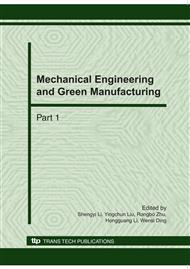p.232
p.238
p.242
p.247
p.252
p.260
p.265
p.271
p.276
Study on Two Kinds of Pneumatic Booster Valves
Abstract:
In order to improve characteristics of booster valve, one kind of pneumatic boost valve was proposed, which makes use of the expansion power, firstly, aiming to the process of pneumatic boosting valves, non-linear differential equations of pneumatic booster valves were set up, using the software MATLAB/simulink for modeling simulation, and variations of flow and pressure of air in boosting chambers and driving chambers were obtained. Secondly, According to the principle of simulation, input pressure-reduced pneumatic booster valve was studied experimentally; curves of exhaust flow and pressure of air in tank were got. As a conclusion, it is clear that simulation and experimental results have a good consistency; flow of air exported by expansion energy-used pneumatic booster valve is larger than that by input pressure-reduced pneumatic booster valve, and the maximum flow is 2.5 times of the flow of air exported by input pressure-reduced booster valve. Because of its compact structure, small size, no external power supply etc., pneumatic booster valve was widely used in locally pressure-boosting occasions of pneumatic system [1-2]. Most of the booster valves were called input pressure-reduced pneumatic booster valve (short for input pressure-reduced booster valve), output pressure of which was set by adjusting input pressure of the driving-champ, such as VBA series of booster valve of SMC Corporation [3]. With the development of energy-saving technologies of pneumatic system, importance of booster valve has become more and more obvious [4]. However this type of booster valve has its own shortages, for example its life is too short and output flow is too small, when boosting-rate is higher, these shortages become more distinct [5-7]. In this paper, firstly, one new type of booster valve (called expansion energy-used pneumatic booster valve, short for quantitative booster valve) was proposed. On the basis of analysis of working principle and structure of both booster valves, mathematic models of the quantitative booster valves were set up, using the software MATLAB/simulink for modeling simulation to research the working processes. Last, According to the principle of simulation, input pressure-reduced booster valve was studied experimentally.
Info:
Periodical:
Pages:
252-259
Citation:
Online since:
October 2010
Authors:
Price:
Сopyright:
© 2010 Trans Tech Publications Ltd. All Rights Reserved
Share:
Citation:


